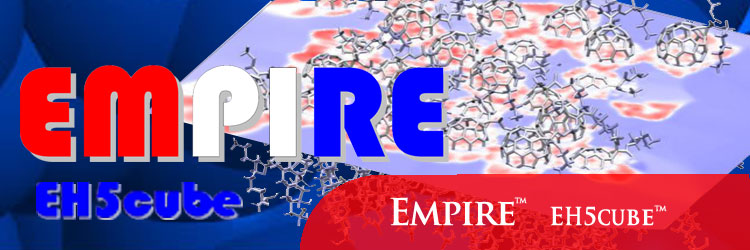
 |
 |
|||
Pricing StructureEMPIRE™ is sold as single-seat or site license for the single node versions or as site license for the multi node versions. Industrial Licenses Academic Licenses |
EMPIRE™ and EH5cube™EMPIRE™EMPIRE™ is a modern, parallel (but not linear scaling) semiempirical molecular orbital program that can treat extremely large systems (it has been tested up to 100,000 atoms for non-periodic calculations and for repeat units in periodic calculations up to 50,000 atoms). EMPIRE™ scales well up to thousands of cores, depending on the size of the system. There is no software-imposed upper limit to the size of the systems that can be calculated. Dispersion-bound Plastic Crystals: MNDO-F molecular dynamicsEMPIRE™ not only includes a very efficient and effective Born-Oppenheiner molecular-dynamics capability [1] but also the novel MNDO-F Hamiltonian, which includes dispersion interactions in MNDO using an innovative “Feynman” perturbation of the electron density. [2-4] A longer (1 ns) NVT simulation at 298 K demonstrates the evaporation of the cluster. This ten-minute video shows the first 0.4 ns of the trajectory: At room temperature, adamantane exists as a plastic crystalline phase, which means that the molecules can rotate on their crystal lattice sites. [5] The following video shows the central adamantane molecule in a 75 picosecond 3D-periodic NVT simulation of the adamantane crystal at 400K with MNDO-F (36 adamantane molecules in the repeat unit). The rotation of the central molecule on its lattice site can be seen near the end of the simulation. Fullerene collision and fusion to a C120 fullertubeThe following video shows the results of an MNDO-F UHF singlet (broken symmetry) simulation of the collision of two C60 fullerenes that initially approach each other at a combined speed of 600 m s-1. The trajectory consists of 5 ps NVE simulation (black background) followed by 10 ps NVT simulation at 1000K (gray background, animation speed doubled) and 10 ps NVT at 298K (silver background). The collision results in the formation of a distorted C120 fullertube that would eventually anneal to a conventional fullertube structure. Program versions EMPIRE20™ has now been released. It includes the following new features:
EMPIRE19™ includes both extensions of the functionality and performance enhancements compared to its predecessor (EMPIRE14™):
Free academic version of EMPIRE™Annual single-seat licenses for the single-node version of EMPIRE™ are freely available for bona fide academic users. To register and download the program, please click here. EH5cube™EH5cube™ is the postprocessor for EMPIRE™ calculations. EMPIRE™ writes a small ASCII output file that contains only the most important information. Its primary (and most detailed) output is a binary wavefunction file in the platform-independent HDF5 format. It is possible to recreate essentially all electronic properties of the molecule or periodic system from the information contained in the .h5 file. EH5cube™ reads the .h5 file and creates, for instance, Gaussian cube files containing the electron density, molecular orbitals or local properties (local ionization energy, local electron affinity or local polarization), either on a grid or at points in space specified in the program input. CADDLE.®A customizable and entirely web-based molecular modeling system including single-node EMPIRE20™ ...more (visit the product side) |
||
|
Copyright © Cepos InSilico GmbH | Impressum | Disclaimer | Sitemap | Products Homepage |
|||